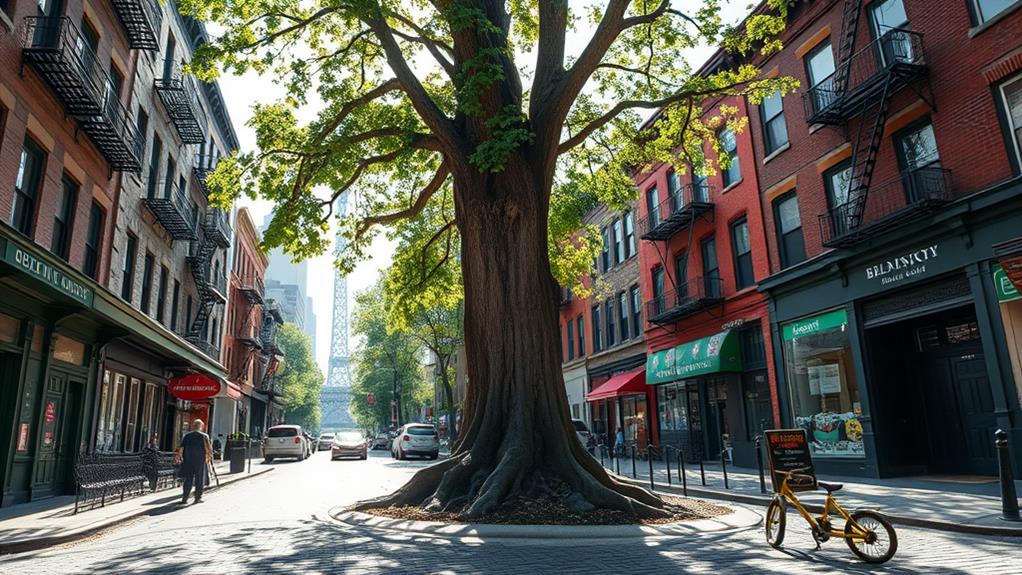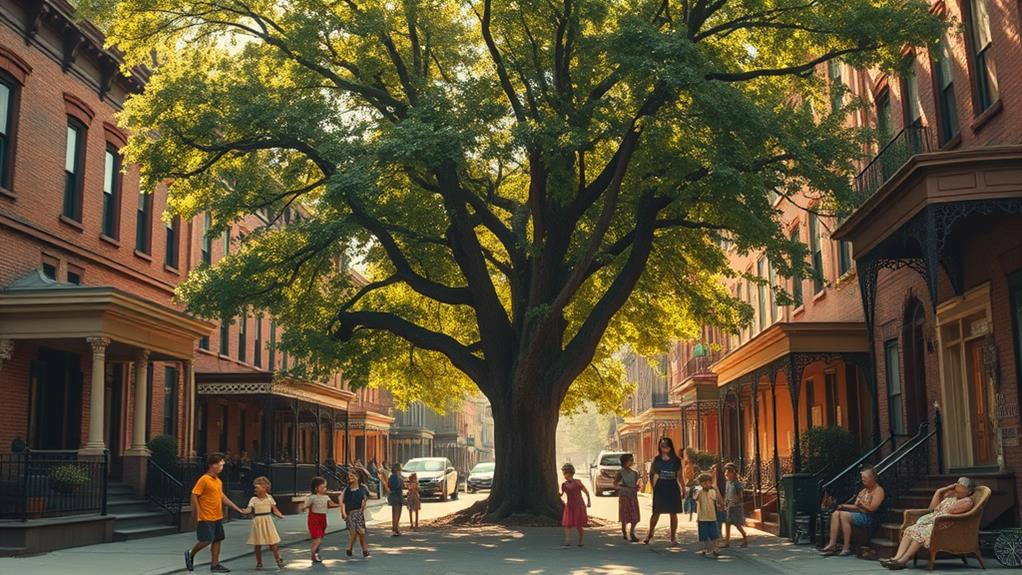If you're looking for a nostalgic plunge into classic American literature, *A Tree Grows in Brooklyn* is a must. This coming-of-age novel follows young Francie Nolan as she navigates poverty and dreams of a better life in early 20th-century Brooklyn. Through her family's struggles and triumphs, you'll witness themes of resilience, education, and the immigrant experience come alive. Betty Smith's semi-autobiographical narrative resonates with readers, making it a timeless exploration of hope and hardship. As you explore this literary gem, you'll uncover deeper connections and insights that speak to the heart of American culture.
Overview of the Novel
*A Tree Grows in Brooklyn* is a poignant coming-of-age novel that captivates readers with its vivid portrayal of early 20th-century Brooklyn.
You'll find yourself immersed in the life of Francie Nolan, an 11-year-old girl maneuvering through the harsh realities of poverty while working to attain the American Dream. The novel intricately weaves the complexities of family dynamics, showcasing Francie's relationships with her parents—her father's struggles with alcoholism and her mother's unwavering sacrifices.
The backdrop of urban poverty and immigrant challenges serves as a constant reminder of the struggles faced by families like the Nolans, highlighting the immigrant experience that resonates with many.
As you follow Francie's journey, you'll witness her resilience and determination against the backdrop of an immigrant experience that resonates with many. The titular tree symbolizes hope and tenacity, thriving despite the unforgiving environment surrounding it.
Divided into five books, the narrative chronicles different stages of Francie's life, emphasizing her educational aspirations amidst societal challenges.
Published in 1943, this novel quickly became a bestseller, capturing the hearts of readers and soldiers during World War II.
Its themes of perseverance and growth guarantee that *A Tree Grows in Brooklyn* remains a timeless classic, continuing to spark discussions in American literature today.
Author's Background
Born into a German immigrant family in Brooklyn, Betty Smith's experiences with financial hardship profoundly shaped her literary voice. Growing up in a struggling household, she faced the same challenges that would later inform her writings, much like Louis Zamperini's survival story in the resilience of the human spirit.
After marrying, she attended the University of Michigan, where she honed her storytelling skills. In 1943, Smith published her semi-autobiographical novel, *A Tree Grows in Brooklyn*, which beautifully captures the resilience and struggles of her youth, particularly through the character of Francie Nolan.
Her life mirrored the themes of poverty and aspiration found in her work, making her narratives authentic and relatable. Beyond *A Tree Grows in Brooklyn*, Smith authored three other novels: *Tomorrow Will Be Better* (1947), *Maggie-Now* (1958), and *Joy in the Morning* (1963).
Each book reflects her mastery of storytelling, resonating with readers who appreciate the intricacies of human experience. Throughout her career, she received multiple accolades, including the Rockefeller Fellowship, acknowledging her significant contributions to literature.
Smith's legacy endures, reminding us of the powerful impact of her background on her writing.
Key Characters

In *A Tree Grows in Brooklyn*, key characters come alive, each embodying the struggles and aspirations of early 20th-century immigrant life. Francie Nolan stands out as the determined protagonist, showcasing resilience as she faces the harsh realities of growing up in poverty. Her journey parallels the themes of personal growth and adversity found in other classic literature, such as Charles Dickens' works that explore the human spirit's resilience against hardship enduring strength found in perseverance. She dreams of a better life, maneuvering her way through the challenges that come with her family's circumstances.
Katie Nolan, Francie's pragmatic mother, works tirelessly to provide for her children despite the burden of her husband Johnny's alcoholism. She symbolizes the strength and sacrifice often found in immigrant families.
Johnny, on the other hand, represents the complexities of the American Dream, as his artistic spirit is overshadowed by his inability to provide stability.
Neeley, Francie's younger brother, also shares in the family's hardships and reveals his musical talent, emphasizing the importance of familial bonds.
Additionally, Sissy, Katie's illiterate sister, adds depth to the narrative, illustrating the contrasts between old-world values and new-world struggles. Together, these characters paint a vivid picture of life in Brooklyn, capturing the essence of family, resilience, and the immigrant experience.
Major Themes
In classic American literature, you'll find resilience amidst adversity as a powerful theme. Characters often embody this strength, showing how they rise above challenges, particularly in tough environments.
This theme resonates similarly in works like *The Book Thief*, where characters display remarkable resilience under oppressive circumstances, facing immense challenges in a climate of fear the dangers of tyranny.
Education also plays a vital role, acting as a key to empowerment and a brighter future for those who pursue it.
Resilience Amidst Adversity
Resilience shines as a powerful theme in classic American literature, particularly in works like *A Tree Grows in Brooklyn*. You witness Francie Nolan embody this resilience as she navigates the harsh realities of poverty and familial struggles. Her determination to pursue education stands out, despite her father's alcoholism and the financial burdens on her family. Each challenge she faces only strengthens her resolve to build a better life.
The Tree of Heaven symbolizes this resilience, thriving even in the toughest urban conditions, much like Francie's spirit. You can see how parental love plays an essential role in their journey; Katie, Francie's mother, works tirelessly to support her children, demonstrating the sacrifices parents make to shield their young ones from adversity.
Through Katie's unwavering support and love, the Nolan family cultivates a tenacity that allows them to confront their struggles head-on.
As you follow Francie's journey, the importance of remembering one's roots becomes clear. The collective resilience of the Nolan family showcases that even amid hardship, they draw strength from one another, illustrating that adversity can be a catalyst for personal growth and determination.
Education as Empowerment
Amidst the struggles of early 20th-century Brooklyn, education emerges as a beacon of hope for Francie Nolan and her family. You see, for Francie, education isn't just a path out of poverty; it's a powerful tool for empowerment. As she discovers her writing talent, you realize how transformative learning can be.
Consider these essential aspects of education in the story:
- Cultural Value: Grandmother Mary instills a reverence for reading and land ownership, showing that education is a way to achieve success.
- Public School as a Lifeline: This system provides immigrant families like Francie's with opportunities that break through socioeconomic barriers.
- Perseverance and Self-Improvement: Despite hardships, Francie's determination in pursuing education illustrates how commitment to learning can lead to a brighter future.
Through supportive teachers encouraging her honesty in storytelling, you see that education transcends mere academics. It's about understanding and expressing personal experiences.
Francie's journey reflects the belief that with perseverance, education can ultimately transform lives and offer a way out of poverty.
Symbolism in the Story

One powerful symbol in *A Tree Grows in Brooklyn* is the Tree of Heaven, which embodies resilience and hope for the Nolan family. This tree thrives in the harshest conditions, mirroring Francie's own journey of growth amidst poverty. As she gazes upon the tree, she sees beauty and potential, reflecting her artistic perspective that allows her to aspire for more than her circumstances suggest.
This theme of resilience is echoed in stories about captivating science stories that highlight how life can flourish even in challenging environments.
The Tree of Heaven serves as a metaphor for the immigrant experience, illustrating how families can flourish despite significant challenges. Its recurring imagery emphasizes the importance of nurturing dreams, even against the backdrop of despair.
Johnny Nolan's struggle with alcoholism contrasts sharply with the tree's enduring nature, highlighting the duality of hope and hardship in their lives.
Francie's relationship with the tree symbolizes her determination to rise above her environment, making it a poignant representation of resilience. In a world filled with obstacles, the tree stands tall, inspiring Francie and her family to seek growth and maintain hope.
Through this rich symbolism, the novel encapsulates the spirit of perseverance inherent in the human experience.
Critical Reception
Since its release in 1943, *A Tree Grows in Brooklyn* has captivated readers and critics alike, quickly becoming a bestseller. Its critical reception highlights the novel's profound impact on American literature, marking it as a true American classic.
You'll find that critics often emphasize three key aspects:
- Emotional Depth: The characters' struggles resonate with readers, evoking deep feelings and empathy. This connection mirrors the importance of resilience and inner strength, as seen in embracing challenges that shape personal growth.
- Immigrant Experience: The story illustrates the challenges and triumphs of immigrant families, making it relatable to many.
- Resilience and the American Dream: The pursuit of happiness amid adversity shines through, showcasing the tenacity of the human spirit.
With an impressive average rating of 4.30 based on over 476,000 ratings, its popularity is undeniable. Readers appreciate the way Betty Smith captures the complexities of family dynamics, which solidifies the novel's relevance across generations.
The 1945 film adaptation further amplified its cultural impact, ensuring *A Tree Grows in Brooklyn* remains a staple in literature classes and discussions. This critical acclaim reinforces its status as a poignant reflection of life and resilience in America, making it an enduring work in the literary canon.
Community Insights

When you read classic American literature, you often find yourself connecting emotionally with characters and their struggles.
The vivid depiction of historical settings gives you insights into the immigrant experience, making you reflect on your own family dynamics.
How do these themes of resilience and survival shape your understanding of life today?
Emotional Reader Connections
Through the lens of *A Tree Grows in Brooklyn*, readers forge emotional connections that transcend time and place. The vivid portrayal of early 20th-century Brooklyn life allows you to immerse yourself in the Nolan family's struggles, making it an enduring piece of American literature.
Consider how the story resonates with you:
- Francie's Resilience: You can relate to her journey of overcoming adversity while holding onto hope and dreams.
- Family Bonds: The strong emphasis on family ties reminds you of your own connections, igniting a sense of nostalgia for shared experiences.
- Empathy for Characters: The poignant father-daughter relationship between Francie and Johnny evokes deep emotional responses, making you reflect on your own familial relationships.
Many readers cherish their annual reading rituals of this classic, reaffirming their personal ties to the narrative.
With an impressive average rating of 4.30 from over 476,000 ratings, it's clear that *A Tree Grows in Brooklyn* resonates deeply across generations. Each turn of the page invites you into a world of struggles and resilience, solidifying the book's place in your heart.
Historical Context Reflections
How do the historical circumstances surrounding *A Tree Grows in Brooklyn* enhance your understanding of its themes? The novel, published in 1943 during World War II, resonates with themes of resilience and the immigrant experience at a time when America faced its own struggles.
As you read, consider how Betty Smith captures the social dynamics of early 20th-century Brooklyn, portraying the challenges faced by Irish, German, and Austrian families. This historical context provides depth to the narrative, reflecting the harsh realities of poverty and the sacrifices families made in pursuit of the American Dream.
The book's popularity as an Armed Services Edition highlights its role in offering comfort to soldiers, reinforcing the universal appeal of hope and perseverance.
The themes of family and education within the immigrant experience remain relevant today, prompting discussions about societal norms and the ongoing journey toward progress.
As you explore *A Tree Grows in Brooklyn*, you'll discover how these historical reflections not only illuminate the characters' struggles but also connect you to the broader tapestry of American life, making the novel a timeless piece of historical fiction.
Cultural Significance
The cultural significance of *A Tree Grows in Brooklyn* can't be overstated, as it vividly captures the immigrant experience in early 20th-century America. The novel resonates deeply with readers, reflecting the struggles and aspirations of families working towards a better life amidst adversity.
Its themes of resilience and the pursuit of the American Dream connect with anyone facing challenges, much like the courage and determination exhibited by women overcoming personal struggles in today's world.
Here are three key aspects of its cultural impact:
- Hope During War: Distributed as an Armed Services Edition during World War II, it offered soldiers a sense of connection to home and hope amidst chaos.
- Enduring Legacy: Its adaptations into a successful 1945 film and musical extended its reach, embedding it into American popular culture and making it a staple of classic literature.
- Contemporary Relevance: Numerous references in music and television today highlight the novel's ongoing connection to themes of struggle and perseverance, proving its timelessness.
Through these elements, *A Tree Grows in Brooklyn* continues to inspire generations, solidifying its place as a quintessential reflection of the American experience.
Historical Context

When you consider "A Tree Grows in Brooklyn," it's crucial to recognize how World War II shaped its themes.
The novel captures the immigrant experience during a time when many faced significant socio-economic challenges while pursuing the American Dream.
This mirrors the struggles depicted in other classic literature, such as the Joad family's journey in the fight against oppression as they sought a better life.
World War II Influence
During World War II, American literature served as a significant lifeline for both soldiers and civilians, providing comfort and a sense of connection amidst the turmoil.
One standout classic, *A Tree Grows in Brooklyn*, published in 1943, became a bestseller, particularly resonating with the American public. It was included in the popular Armed Services Editions, ensuring soldiers had access to free copies. This connection to home was essential during such challenging times.
Here are three ways the novel impacted readers during the war:
- Themes of Resilience: The struggles of the characters reflected the hardships faced by soldiers, offering them hope and strength.
- Cultural Significance: Its portrayal of the immigrant experience resonated with many, reminding them of their roots and the family bonds that mattered most.
- Fan Mail from Soldiers: Many expressed gratitude for the book, highlighting how it resonated with their experiences and provided solace during the war.
The rapid reprints of *A Tree Grows in Brooklyn*, with around 50,000 copies printed, showcased its immense popularity and enduring impact on American culture during this pivotal moment in history.
Immigrant Experience Reflected
American literature, particularly in works like *A Tree Grows in Brooklyn*, reflects the immigrant experience with striking clarity. The novel centers on Irish immigrants endeavoring for the American Dream amid economic hardship, revealing the harsh realities they face, such as poverty and discrimination. You see the resilience and tenacity of families who persevere against the odds, instilling hope for a brighter future.
Through the character of Francie Nolan, you witness generational challenges where traditional values clash with the aspirations of the younger generation. This dynamic illustrates the immigrant experience's complexity, as children seek social mobility while grappling with their cultural displacement.
Betty Smith, drawing from her own background as a child of German immigrants, emphasizes the importance of education and self-improvement as crucial pathways out of poverty.
In *A Tree Grows in Brooklyn*, the struggles and triumphs of immigrant families resonate deeply. While they navigate their identity in a new land, their stories embody the universal themes of resilience and hope, reminding you of the enduring spirit that defines the immigrant experience in America.
Legacy and Influence
Classic literature often leaves a lasting impact, and *A Tree Grows in Brooklyn* is no exception. Its legacy and influence on American literature resonate deeply, touching on themes of resilience, poverty, and the immigrant experience.
The novel's exploration of these themes parallels the courage and defiance shown by individuals in times of struggle, much like the acts of courage and defiance seen during World War II resistance movements. You can see its mark through various avenues:
- Cinematic Adaptation: The 1945 film directed by Elia Kazan brought the story to life for a broader audience, reinforcing its themes and introducing it to new generations.
- Cultural Relevance: As an Armed Services Edition during World War II, it offered soldiers a sense of home, showcasing the universal pursuit of the American Dream.
- Enduring Discussions: The novel's exploration of family dynamics continues to inspire critical analyses in literature classes, ensuring its place in academic discussions.
Through its numerous adaptations and references in music and television, *A Tree Grows in Brooklyn* has solidified its cultural impact, proving that its exploration of the American Dream remains essential.
This classic not only reflects the struggles of its time but also connects to the ongoing narratives of resilience in contemporary society.
Conclusion
In "A Tree Grows in Brooklyn," you see the resilience of the human spirit blooming amidst hardship. As you reflect on Francie's journey, you can't help but wonder: what dreams have you nurtured in the cracks of your own life? This timeless tale invites you to embrace hope and perseverance, reminding you that even in the toughest conditions, growth is possible. Its legacy continues to inspire, urging you to chase your dreams, no matter the obstacles.



